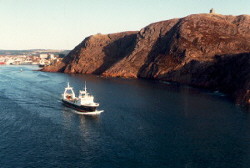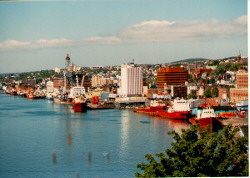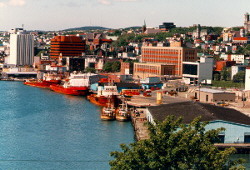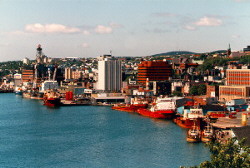

Today St. John's is the commercial, administrative, social and political centre of Newfoundland. Other towns and centres like Grand Falls or Corner Brook are beginning to challenge the monopoly St. John's once had in these aspects of Newfoundland life, but the capital city still towers above every other community. Nearly one-quarter of our population lives in its area and many more are close by.
To some extent we accept this as a historical fact without wondering why this should have happened. Today we are part of Canada and the decline in our links with Western Europe, the West Indies and the United States is forcing us to look more towards the centre of the Nation. If we do this, then St. John's seems to be a rather silly place for a capital since it is as far from the mainland as one can get. Instead of being a natural centre of communications, it seems more like the last port of call; the last town on a string which runs right across Canada.

However, communities (until very recently) did not become large overnight; they developed over long periods of time in answer to the slow but continuous changes affecting the people who lived or traded in the areas around them. The justification for St. John's as a capital reached its height in the nineteenth century when it acted as the major controller, indeed in many cases was the monopoliser of the fishing and sealing activities on the East Coast and on the Labrador. Even so, however, there was nothing God-given about its prominence which reflected the state and nature and extent of English occupation in Newfoundland during the eighteenth century especially after the American Revolution.
We sometimes forget, for example, that the first colonists did not choose to settle in St. John's but in places like Harbour Grace, Cupids, or Ferryland. This was partly due to the fact that St. John's was then visited by many fishermen from foreign countries, but as late at the 1670's when the English Shore was monopolised by Britain, the population of St. John's barely exceeded that of Ferryland or Bay de Verde. Indeed, in one winter Old Pelican had a larger population than St. John's. This is not difficult to understand: the only reason why men visited or settled in Newfoundland was to catch fish and St. John's is not a good place for inshore fishermen to operate from - at least it will not support a large population if they must live off their own fishing. However, although as yet St. John's was of no great economic importance - and certainly had no economic influence over the other ports - it already stood out as a communications centre. The Old English Shore ran from Trepassey to Greenspond, and the fishery was carried on in roughly equal quantity on the Southern Shore (south of St. John's) and to the northwards. With its secure natural harbour, St. John's was roughly in the middle of the coastline and was a natural focus for communications. The sack ships looking for fish cargoes or trying to find the best place to sell their provisions were already coming first to St. John's to obtain news of what was happening elsewhere. This central position was eventually to make St. John's the capital of Newfoundland.
Despite this, St. John's was still little more than a port of call for vessels which would in the end go elsewhere to pick up their fish. It was not even thought to be the best place for military and naval purposes - the convoys assembled and dispersed at Bay Bulls, which was thought to be better. The real beginning of St. John's as our capital came in 1697 when as a result of King William's War, the government decided to build a fort and establish a military garrison at St. John's. By 1713 - although the town was still very small - it had become clearly established as the administrative and communications centre for the English Shore. Its expansion was greatly helped by the development of the English fishery on the Grand Banks. St. John's was the largest centre for this deep sea fishery and the bankers coming out from England with passengers discharged them at St. John's before going out to fish. At the end of the season passengers returning to Britain travelled to St. John's to find a bank ship which would take them home. In 1720 it was said that most of the planters in St. John's had abandoned their fishing and turned to keeping public houses and taverns. The pattern was thus established; St. John's would develop as a commercial, administrative and communications centre - and the fishermen would settle in other parts of the Island.
When the government created a naval governor and justices of the peace in 1729, St. John's received a further boost, for the Governors invariably stationed themselves in St. John's and the magistrates of the city came to have a higher rank and authority than did those in the other districts. Between 1730 and 1765 the establishment of a criminal court and of customs and naval officers further raised St. John's above the other communities. On the eve of the American Revolution in 1775, St. John's was clearly dominant in all but purely economic functions. Nevertheless, it did not control the rest of the Island. As late as 1785 a Poole merchant with a very extensive business in Trinity and Bonavista Bays said (rather sourly) that St. John's was "a mere Portsmouth, or rendezvous for the Army and Navy" and that it did not have one-third of the trade of the other mercantile centres. His remark was a little exaggerated, but it is true that with the exception of such local harbours as Torbay or Petty Harbour the merchants of St. John's had little influence or connection with the inshore and offshore fishermen who were supplied by merchants in their own locality. Indeed, the most wealthy merchants in Newfoundland between 1775 and 1793 did not trade from St. John's but from Trinity. Such places as Harbour Grace, Carbonear, Ferryland, Placentia and Little Bay could boast merchants who were as large and important as any in St. John's. They obtained their capital, their immigrants and their supplies directly from abroad and marketed their fish directly. They had little interest in St. John's and St. John's certainly had no influence over them.
However, between 1775 and 1815 the situation changed dramatically and the end of the Napoleonic Wars saw St. John's dominant not only in the military and administrative, but to a growing extent the economic, life of Newfoundland. The changes caused by the American Revolution - the development of the trades to the West Indies and Canada, the growth of a large number of small tradesmen and dealers in St. John's and the gradual (in some cases very rapid) decay in the economy of many of the smaller ports which had depended heavily upon the West of England migratory fishery - all helped St. John's to rise. The growth of the Scottish trade to Newfoundland which was centred mainly on St. John's and the transfer of many business houses from England to St. John's during the Napoleonic Wars were also important factors . As the outport merchants lost their money and weakened or disappeared into bankruptcy, the Water Street merchants took over the trade of the local men. Even where local merchants remained many were not truly independent, being financed by and tied to their larger brethren on Water Street. The astonishing growth of the Labrador fishery and the sealing industry also helped, for St. John's was admirably suited - as the strongest financial and trading centre - to control these industries.

As the importance and wealth of St. John's grew, it gradually acquired social and cultural advantages. St. John's had newspapers, health services, superior educational and charitable facilities and as the only town in Newfoundland with a large educated and moderately wealthy middle class - it increasingly attracted the outport middle classes, who found life more varied and exciting there.
Inevitably, St. John's took the lead in the agitation for political and social reform and just as inevitably, it became the political centre of the Island in 1832. This did little more than confirm what was already obvious; St. John's had become the dominant influence in Newfoundland life. During the nineteenth century the outports continued to decline in wealth and influence, and as the independent and wealthy merchants disappeared from Trinity, Twillingate, Placentia, Harbour Grace and Carbonear, St. John's loomed even larger in the life of the Island. The outports did not die easily, and for much of the nineteenth century Harbour Grace, Trinity and Carbonear retained great prosperity and local influence. By 1900, however, they were all in decline - except possibly some of the ports on the South Coast. In the twentieth century St. John's hastened to swallow up all the rest. In the seventeenth century it was remarked that London was doing the same for the outports of England. Ironically, St. John's reached its height just as the development of the West Coast and of non-fishing industries, combined with our entry into Canada and the decline of the fishery made it less natural as our capital. It is certainly arguable that the historic reasons which made St. John's so dominant no longer exist. Unfortunately, once a large city comes into being it acquires a dynamism of its own. Today, while it is not the best possible place for a capital city, St. John's is the only one we have or are likely to be ever able to afford.

ST. JOHN'S HARBOUR.